Around the iconic Azadi Tower in Tehran, larger crowds than have gathered in previous years will be expected, as commemorations of the fortieth anniversary of the Iranian Revolution go ahead. Its success will undoubtedly be regarded by many in the country as an act of defiance against the West.
That is certainly the opinion of Iran’s Interior Minister, Rahmani Fazli, who said of the celebrations, “the people’s turnout and their support for the country have always led to the despair and disappointment of […] enemies”, the Tehran Times reported.
There will in Washington be an equal sense of defiance, as the strong sanctions that President Trump’s government have levied against Iran continues. John Bolton, the U.S. National Security Advisor last year made his feelings towards the Islamic regime clear, remarking “America’s declared policy should be ending Iran’s 1979 Islamic revolution before its 40th anniversary”, the WSJ reported.
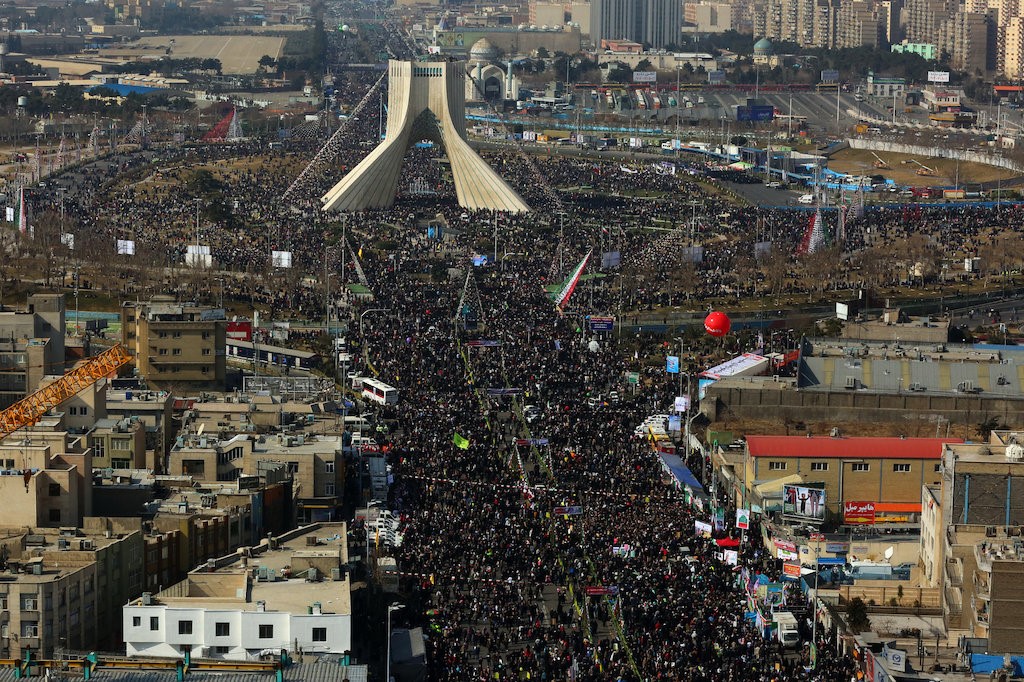
Aerial photos show crowds of people during a Tehran parade on February 11, 2018, from khamenei.ir
What led to the Revolution?
Before Iranian revolutionaries established an Islamic theocracy, severing the countries International relations, Iran was a growing global influence under Shah Mohammad Reza Pahlavi, whom the U.S. helped bring to power in 1953.
As the main power broker in the region, Iran was a crucial ally for a U.S. which was reluctant to engage in any kind of international conflict while it was deeply embedded in the Vietnam War.
From 1963 till the year of the revolution the Shah implemented radical changes to the Iranian social structure in what became known as the White Revolution. Land was taken out of the hands of land lords and given to the peasantry. The most radical changes however were for women, who for the first time were given the right to vote.
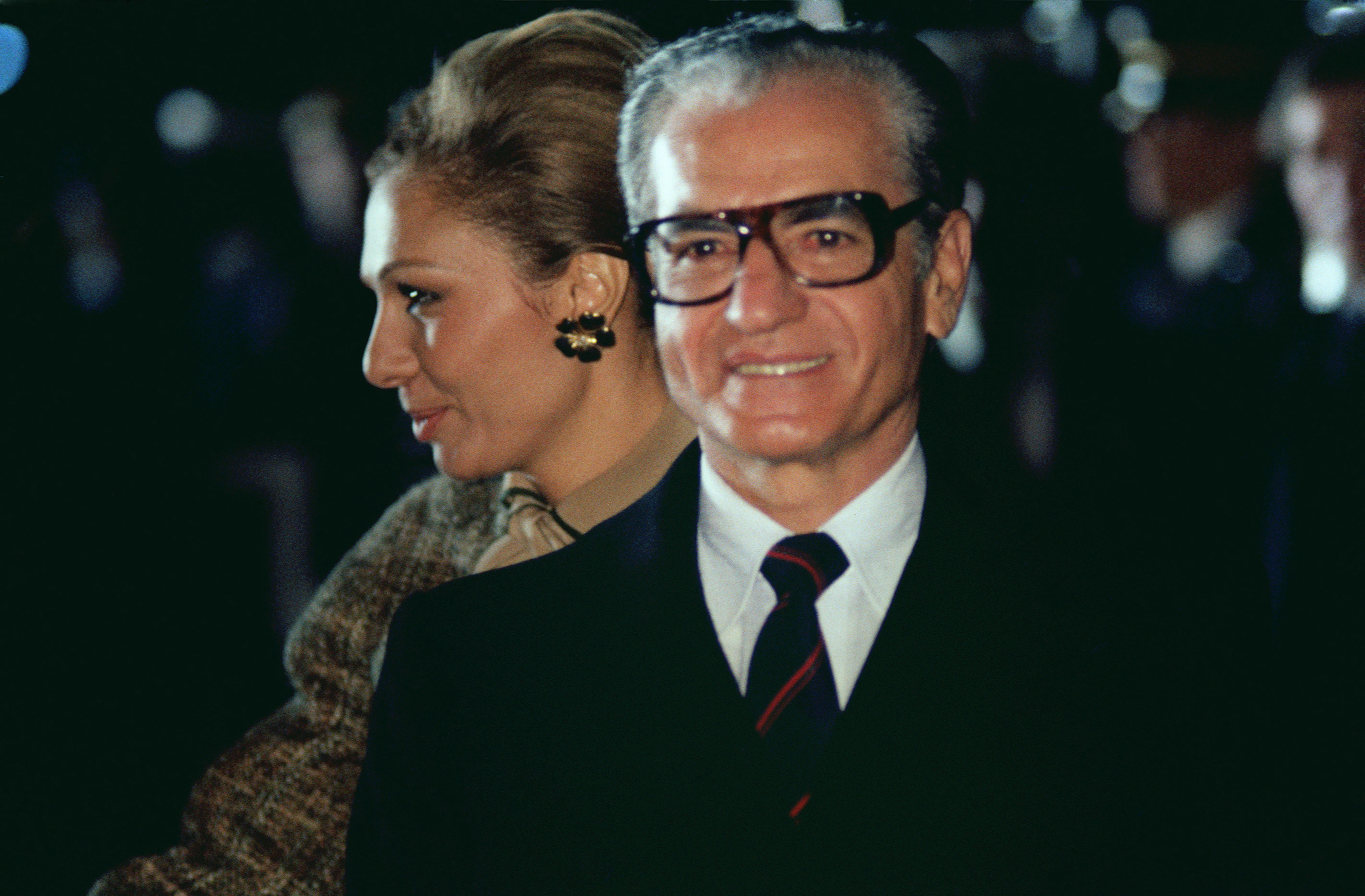
Mohammed Reza Pahlavi, Shah of Iran, and his wife, Queen Farah, prepare to depart after a visit to the United States, Available from Wikimedia
Despite some positive outcomes, such as increased literacy across the country, many of the good intentions of the White revolution backfired. Rather than giving more power to the peasantry, the land reforms had negative consequences, pushing them into industrial cities, and creating a class of unskilled labourers, who were both religiously conservative, and angry towards the establishment.
In the 1970s inflation increased making life even more difficult for this embittered class; while the Shah and his family lived in luxury, having amassed a vast personal fortune due to the oil boom in that decade.
Later in his reign the Shah made a series of political errors. These included disestablishing all political parties, bar one (which all Iranian’s were required to join). The countries official Islamic calendar was also replaced by one which began from the conquest of Babylon by Cyrus the Great, marking 2,500 years of Persian monarchy.
The consequence of these, and other decisions emboldened the governments critics, especially from the Shiʿah clergy. None were more vocal in their criticism than Ayatollah Ruhollah Khomeini.
Khomeini had already been expelled from the country from 1963, following a series of attacks against the Shah, spending most of his time in exile in Iraq. Outside of Iran he remained a vocal critic of the Shah, and increasingly called for Iran to be governed by his interpretation of Shariah law.
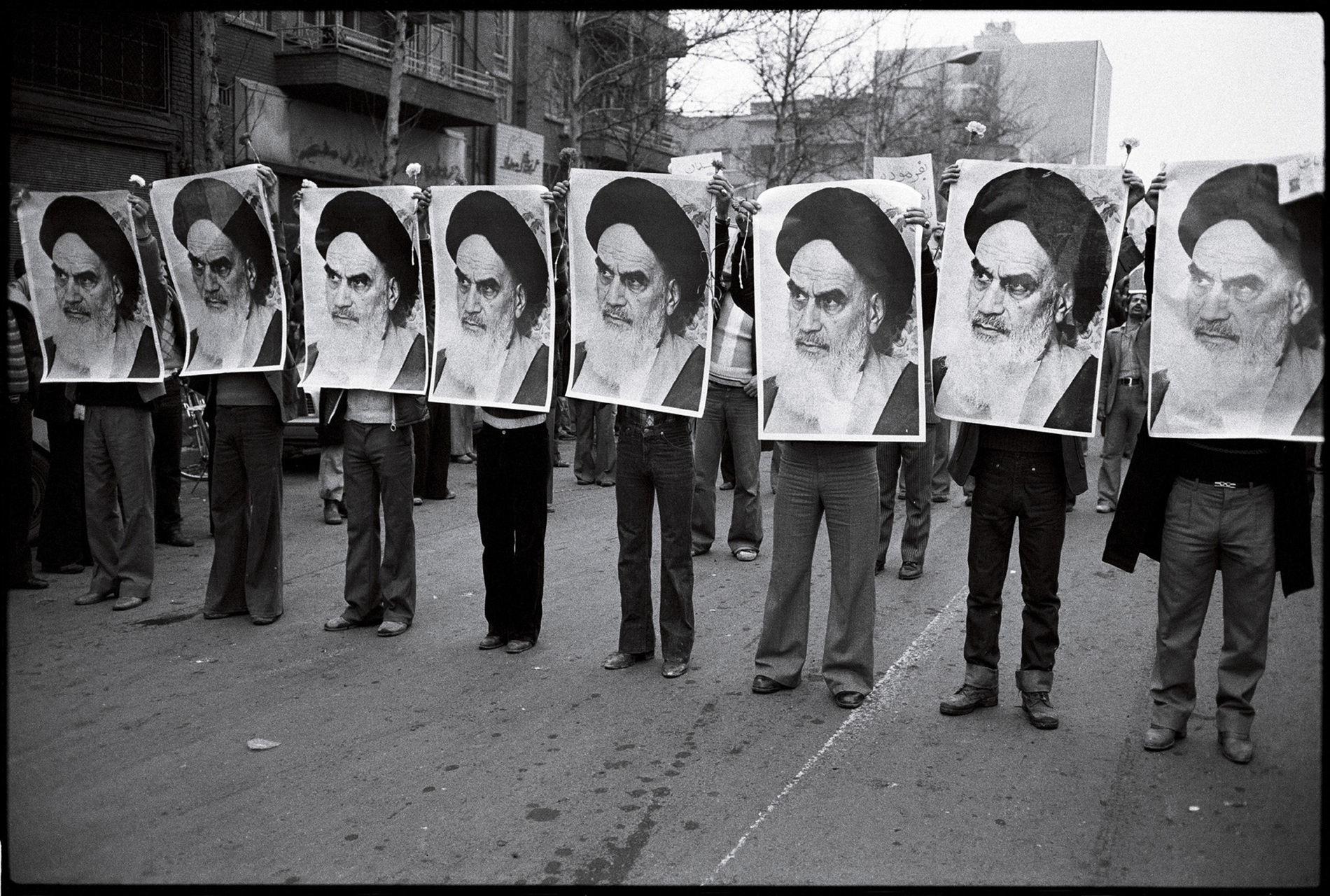
1978 Iranian revolution – row of men holding Khomeini’s photos, from Wikimedia
When Khomeni returned on 1 February 1979 (following the exile of the Shah to Egypt), he was greeted by millions of Iranians in Tehran celebrating his arrival.
Skirmishes between pro and anti-monarchical forces occurred in the proceeding ten days. But by 11 February, Khomeni secured his power, personally selecting Mehdi Bazargan as the Prime Minister, proclaiming that decision to be God’s will.
What were the consequences?
Immediate aftermath
After the revolution Khomeni and his political allies further cemented their grip on the country. They did so by establishing its influential institutions which persist today; the Revolutionary Council, and the Revolutionary Guard.
The new Iranian constitution, which many expected to usher in democratic change, under Khomeni became theocratic, as Shiʿah clerics were given more authority in government.
In November 1979 an international crisis broke out when a group of student supporters of the Revolution stormed the American embassy in Tehran, demanding the Shah be returned from exile, and taking 52 American’s hostage. While Khomeni supported the action, Prime Minister Bazargan strongly opposed it, and consequently resigned his post.
As a result of the hostage crisis the first U.S. backed sanctions against the country came into effect in 1979. The crisis ended with the signing of the Algiers Accords in 1981, when all the hostages were allowed to return to the U.S. But American-Iranian relations were soured ever since.
Internal instances of criticism and resistance did occur; from the leftist President Abolhassan Banisadr, to the cleric Mohammad Kazem Shariatmadari. But all opposition eventually was crushed by pro-Khomeni forces.
The tumultuous decade
- In 1980 Iran was invaded by Iraq under the leadership of Saddam Hussein. By the end of the war in 1988 Iran had managed to maintain all of its disputed territory. During the war, Iraq had been backed by the U.S., the Soviet Union, and most Arab countries.
- From 1981 till 1987, despite publicly supporting Iraq during the war, U.S. government officials secretly sold arms to the Iranian government. In 1985 Lieutenant Colonel Oliver North began diverting funds from the arms sales to the Contras (anti-communist forces in Nicaragua), in what became the Iran-Contra affair.
- In 1989, Khomeni called for the assassination of British author Salman Rushdie, alleging his book The Satanic Verses to be blasphemous. Rushdie survived assassination attempts; but the books Japanese translator Hitoshi Igarashi was murdered.
- On 3 June 1989 Ruhollah Khomeini died after suffering five heart attacks. Ali Khamenei, who served as President of Iran from 1981 till 1989 succeeded him as Supreme Leader, maintaining that position today.
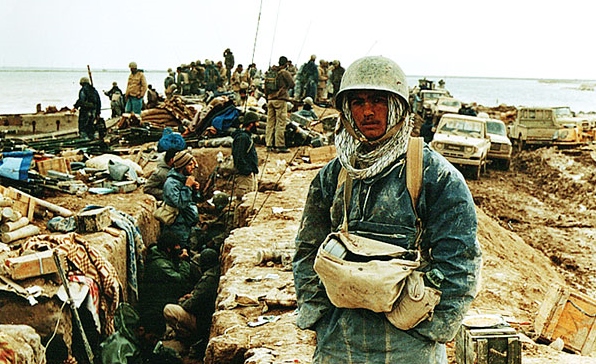
Iranian Troops in Forward Trenches during Iran Iraq War, available from Wikimedia
1989 to 2012
Following the tumultuous 1980’s, from the early ‘90s some Iranian officials focused on improving the country’s overall economic performance. Reformers however faced a series of obstacles against this agenda, mainly coming from the conservatism of the Guardian Council against implementing Western policies.
Iran was subject to a series of sanctions from the U.S. (1987, 1995, 2006, and 2012), and from other major powers. Most of these economic sanctions were imposed because of Iran’s support for Islamist militant organisations (such as Hezbollah), as well as fears that Iran had been developing Weapons of Mass Destruction.
The administration of conservative populist Mahmoud Ahmadinejad from 2005 to 2013 escalated tensions between Iran and Western Powers. Ahmadinejad’s fiery statements, including Holocaust denial and 9/11 conspiracy theories, were regularly perceived as offensive and as intended to provoke animosity, particularly against the U.S. and Israel.
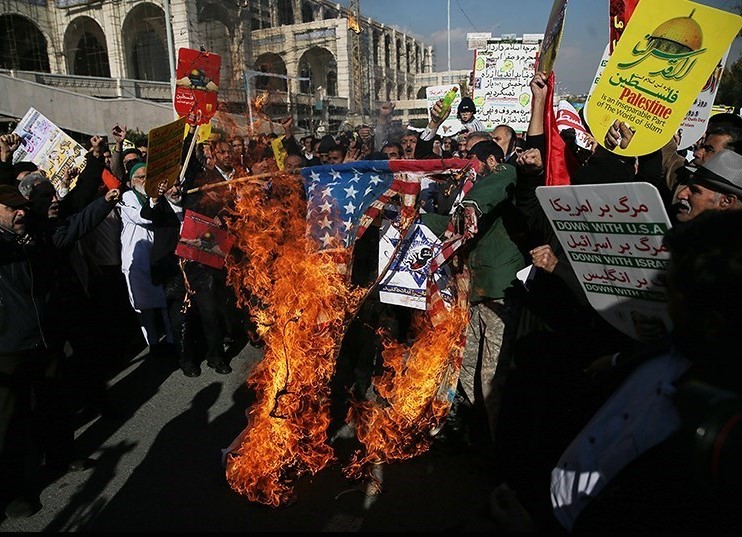
Demonstrators burn the U.S. flag in protest of President Trumps recognition of Jerusalem as Israel’s Capital, 8 December 2017. This contrasts with pre-revolutionary Iran, which was the second Muslim country to formally recognise Israel, after Turkey. Available at Wikimedia
International relations Today
Following the election of President Hassan Rouhani, a political moderate and reformer, in 2013, there were hopes from Western powers that more amicable relations with Iran could develop.
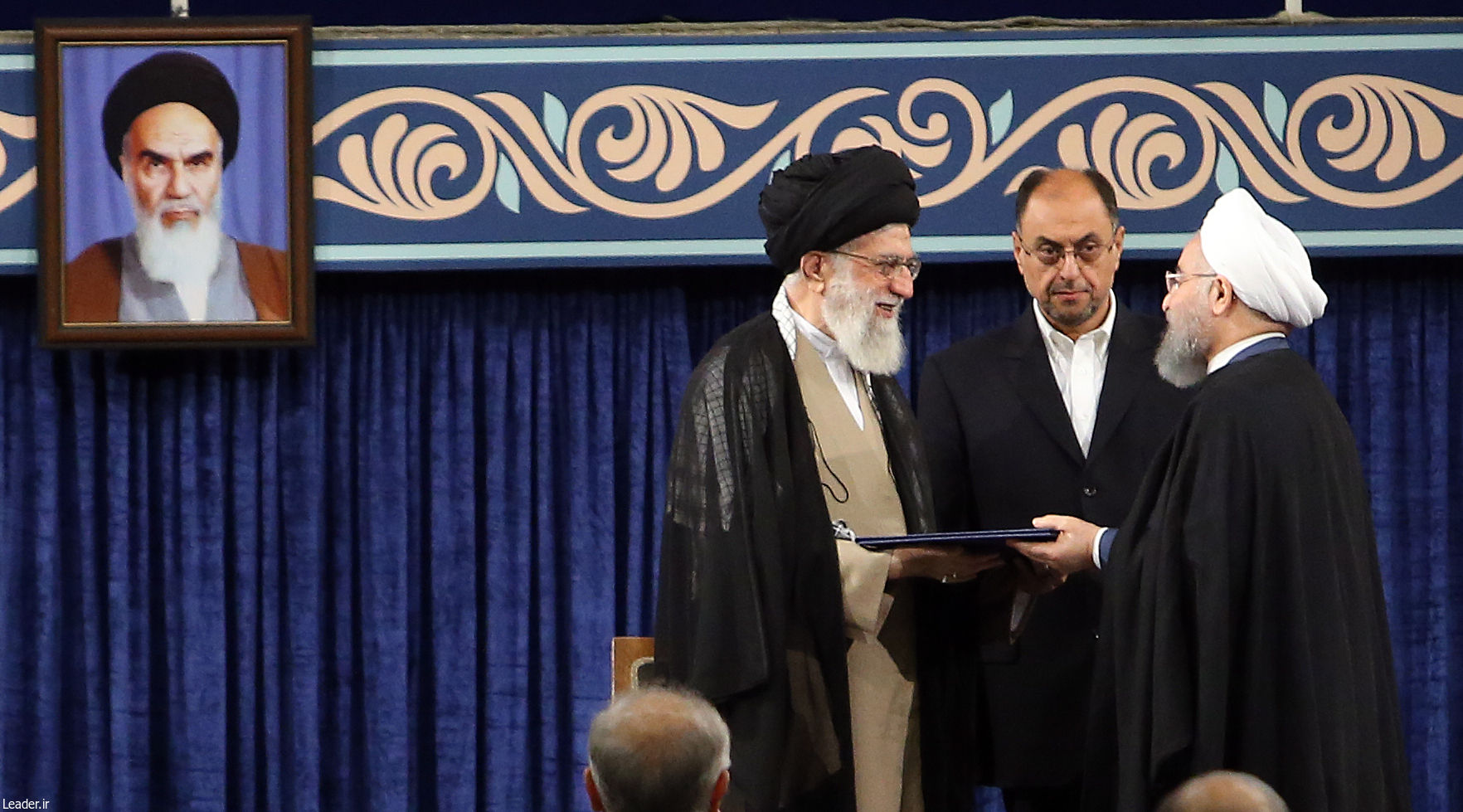
Ayatollah Khamenei endorses presidency of Hassan Rouhani in an official ceremony in Tehran, from leader.ir
In July 2015, the U.S. (under Barack Obama’s administration), the United Kingdom, Russia, China, France, Germany and Iran agreed on the Iran Nuclear Deal. This deal would limit economic sanctions, in exchange for Iran limiting its Nuclear enrichment activities.
However, in May 2018 President Donald Trump announced that the U.S. would withdraw from the agreement, claiming Iran is the “leading state sponsor of terror”, and that the deal was “horrible”.
President Trump Gives Remarks on the Joint Comprehensive Plan of Action, published 8 May 2018, available from the White House YouTube page
In November 2018, the U.S. officially re-imposed all economic sanctions against Iran. President Rouhani criticised the U.S. President, stating Mr Trump “is not loyal to international commitments”, CNN reported. The other signatories of the Iranian deal have remained committed to the Joint Comprehensive Plan of Action.
Tensions between the U.S. and Iran are perhaps at their lowest since the 1979 hostage crisis. The sanctions have also further escalated tensions between Iran, the U.S., and other countries.
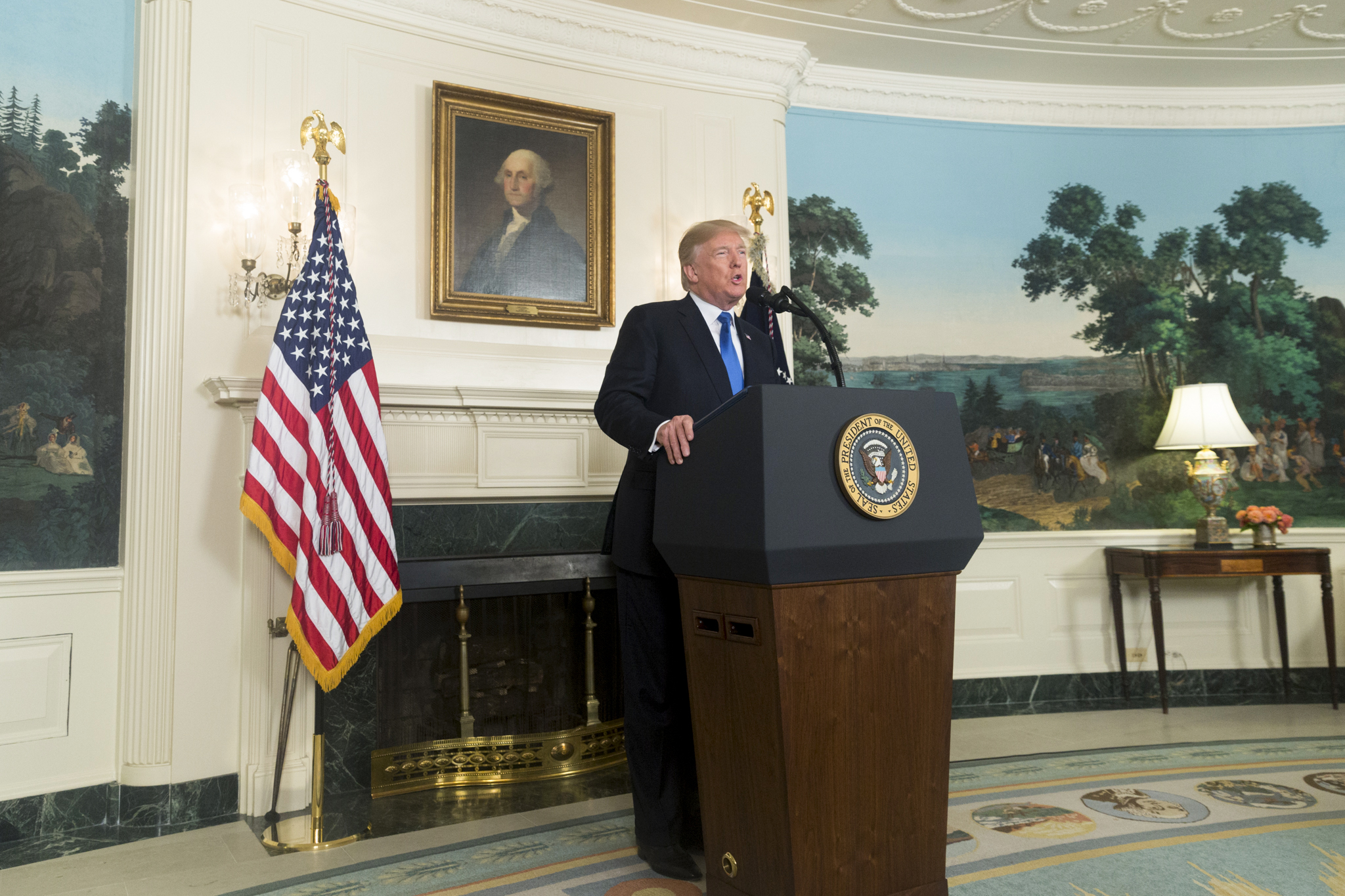
President Trump Announces Iran Strategy, uploaded October 13, 2017 to whitehouse.gov
On 1 December 2018, Meng Wanzhou, daughter of the founder of the Chinese telecoms company Huawei, was arrested in Canada on a U.S. warrant. The arrest was made on allegations that Huawei secretly sold telecoms equipment in Iran (despite the sanctions) through a fraudulent company. This has resulted in major tensions between China, Canada, and the U.S.
With an ongoing proxy war also continuing in the Middle East, with Iran, backed by Russia on one side, and Saudi Arabia, backed by the U.S. on the other, animosity between the U.S. and Iran looks set to set to worsen, before it gets better.
Cover Photo: Basij forces meeting Ayatollah Khamenei, 22 Nov 2017, from Khamenei.ir
Share this post: on Twitter on Facebook on Google+



0 Comments